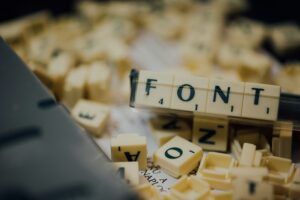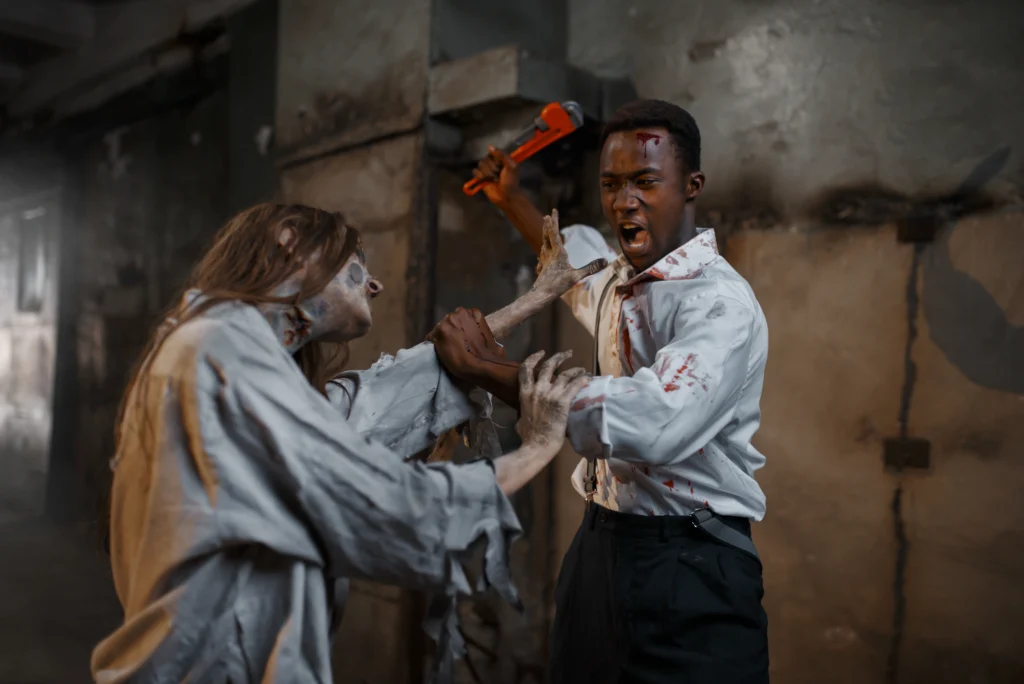The fonts used in horror movie titles play a significant role in setting the tone and atmosphere for the film. These typefaces are often designed to evoke feelings of fear, suspense, and tension, complementing the horror genre’s dark and unsettling themes. This article delves into the fonts commonly used in horror movie titles, analyzing their characteristics and exploring why they are so effective in eliciting the desired emotions from the audience.
The Role of Typography in Horror Movies

Typography is one of the most powerful visual elements in horror movie marketing. The font used in the title of a horror movie can make an immediate impact, offering the viewer a glimpse of the fear and anticipation that lies within the film. The right font can turn a simple title into an ominous message, signaling to the audience that they are about to experience something chilling.
In horror movies, typography is not just a design choice; it becomes part of the storytelling. A carefully selected font can create a sense of dread and foreboding even before the opening scene. From jagged letters that suggest violence to distressed and weathered typefaces that convey decay and despair, horror movie fonts are meticulously chosen to enhance the viewer’s emotional response.
Common Fonts in Horror Movie Titles

Several fonts and typefaces have become synonymous with horror films over the years. Some of these are custom-designed for specific movies, while others are readily available fonts that have been popularized by the genre. Let’s explore some of the most common fonts used in horror movie titles.
- Trajan – Trajan is a classic serif typeface that has been used in a number of horror films, including “The Exorcist” and “Dracula.” Its Roman origins give it a timeless, authoritative feel, often evoking themes of fate and inescapable doom.
- Futura – Despite its modern, clean design, Futura has been used in horror movie titles like “Psycho.” Its sharp, geometric shapes can create a sense of unease when placed in the context of horror.
- Helvetica – Helvetica, a widely used sans-serif font, has appeared in titles like “Halloween.” Its neutrality allows it to act as a blank canvas, heightening the impact of eerie visuals that accompany it.
- ITC Benguiat – This font gained renewed popularity with “Stranger Things,” but its roots in the horror genre go deeper, having been used in titles like “Stephen King’s It.” The typeface’s bold, vintage feel adds to the suspenseful atmosphere of the stories.
- Custom Handwritten Fonts – Many horror movie titles, especially those dealing with psychological horror, make use of custom handwritten fonts that appear erratic and unpolished, evoking feelings of madness and instability.
The Psychology Behind Horror Fonts

The fonts used in horror movies are carefully selected to trigger subconscious emotional reactions in the audience. Different fonts convey different emotions, and horror fonts are designed to exploit our deepest fears.
- Jagged Edges – Fonts with sharp, jagged edges are commonly used to signify danger or violence. The irregularity of the letters creates a sense of unpredictability, tapping into the audience’s fear of the unknown.
- Distressed and Decayed – Fonts that look worn, decayed, or weathered are often used in titles for supernatural or post-apocalyptic horror films. These fonts symbolize decay and destruction, which are central themes in many horror narratives.
- Bold and Blocky – Large, bold fonts are used to create a sense of dread and inevitability. These fonts dominate the screen, making the viewer feel overpowered and helpless, much like the characters in the film.
- Thin, Wispy Fonts – Delicate, almost invisible fonts are often used in ghost stories or psychological horror. These fonts evoke fragility and uncertainty, emphasizing the elusive nature of the threat in these types of films.
Classic Examples of Horror Movie Fonts

Many iconic horror movies have used fonts that have become as famous as the films themselves. Below are a few classic examples:
- The Shining – The title font of “The Shining” is an ultra-bold sans-serif typeface that fills the screen, creating a claustrophobic feeling that mirrors the film’s isolated, psychological terror.
- Nightmare on Elm Street – This film’s title uses a handwritten font that looks like it was scrawled in blood, perfectly capturing the slasher genre’s emphasis on violence and chaos.
- Psycho – The original “Psycho” title used a simple, bold font with a fractured effect, representing the split personality of the film’s antagonist. The font, combined with Bernard Herrmann’s chilling score, sets the tone for one of the most iconic horror films in history.
- The Exorcist – The title font for “The Exorcist” uses Trajan, a stately, classical serif font that hints at the ancient evil the film portrays. Its simplicity is part of its power, allowing the subject matter to speak for itself.
Modern Horror Movie Fonts

In recent years, modern horror films have experimented with a wider range of fonts, from minimalist sans-serif typefaces to highly stylized, custom fonts. Let’s look at some notable examples:
- Hereditary – The title for “Hereditary” uses a delicate serif font with slight flourishes, which contrasts with the film’s gruesome content. This juxtaposition adds to the unease felt by viewers.
- Get Out – “Get Out” uses a clean, minimalist sans-serif font, allowing the disturbing imagery to take center stage. The simplicity of the font reinforces the film’s theme of underlying, hidden horrors.
- Midsommar – “Midsommar” uses a Gothic-inspired font that is reminiscent of ancient European manuscripts. This choice reflects the film’s exploration of pagan rituals and old-world traditions.
- The Witch – The title of “The Witch” employs a blackletter font, which has historical connotations of witchcraft and dark rituals. The font immediately sets the tone for a story steeped in superstition and dread.
Why Fonts Matter in Horror Movie Titles

The importance of fonts in horror movie titles cannot be overstated. A well-chosen font not only enhances the visual impact of a movie poster or opening credits but also serves as a crucial element in building the overall atmosphere of the film.
Horror movie fonts create an immediate emotional response, preparing the audience for what they are about to experience. They can evoke feelings of fear, discomfort, or anticipation with just a glance. The right font becomes a visual shorthand for the film’s themes, allowing the audience to begin their journey into the horror narrative before the first frame even appears.
Conclusion
The fonts used in horror movie titles are carefully crafted to elicit a visceral reaction from the viewer. Whether through jagged edges, decayed typefaces, or bold, overpowering designs, these fonts work to heighten the sense of dread and anticipation that defines the horror genre.
From classics like “The Shining” and “Psycho” to modern films like “Hereditary” and “The Witch,” horror movies rely on typography as a key element of their visual storytelling. By understanding the psychology behind these fonts and the emotions they invoke, designers and filmmakers can create titles that resonate deeply with audiences and set the stage for unforgettable cinematic experiences.
In conclusion, the next time you watch a horror movie, take a moment to appreciate the font choice in the title. It may seem like a small detail, but it’s a vital part of the overall horror experience. The font is often the first piece of the puzzle, giving you a hint of the terror that awaits. As horror films continue to evolve, so too will the fonts used to convey their unique, spine-chilling stories.


